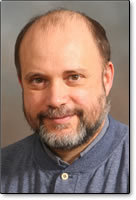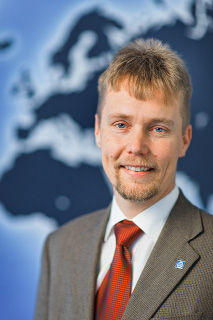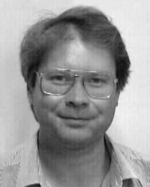 |
J. Sifakis, VERIMAG, FR (Slides) Topic: Embedded Systems – Scientific Challenges and Work Directions Abstract: Embedded systems are components integrating software and hardware jointly and specifically designed to provide given functionalities, which are often critical. They are used in many applications areas including transport, consumer electronics and electrical appliances, energy distribution, manufacturing systems, etc. Short biography: Joseph Sifakis is a CNRS researcher and the founder of the Verimag laboratory in Grenoble, France. He holds the INRIA-Schneider endowed industrial chair since September 2008 and he is the director of the CARNOT Institute « Intelligent Software and Systems ». He studied Electrical Engineering at the Technical University of Athens and Computer Science at the University of Grenoble. Joseph Sifakis is recognized for his pioneering work on both theoretical and practical aspects of Concurrent Systems Specification and Verification. He contributed to the emergence of the area of model-checking, currently the most widely-used method for the verification of industrial applications. His current research activities include component-based design, modeling, and analysis of real-time systems with focus on correct-by-construction techniques Joseph Sifakis is the founder of Verimag, a leading research laboratory in the area of critical embedded systems, and has broad experience with industry, including Airbus, Astrium, the European Space Agency, France Telecom, ST Microelectronics. He is the Scientific Coordinator of the European Network of Excellence ARTIST2 on Embedded Systems Design, which gathers 35 of the best European teams and in the area and key European industrial partners. Joseph Sifakis has received the Turing Award in 2007, with Ed Clarke and Allen Emerson, for their contribution to Model Checking. He is also the recipient of the CNRS Silver Medal in 2001, Grand Officer of the French National Order of Merit, and a member of Academia Europea and of the French National Academy of Engineering. |
 |
F. Baccelli, INRIA, FR (Slides) Topic: Wireless Routing on a Poisson Point Process Abstract: We introduce a new random graph for analyzing multihop routing in wireless ad hoc networks, the space-time SINR (Signal to Interference and Noise Ratio) random graph. Short biography: François Baccelli’s general research interests are in the theory of stochastic networks and in the modeling and performance evaluation of computer and communication systems. He coauthored research monographs on the following topics: point processes (with P. Bremaud in 87), the max plus algebra (with G. Cohen, G.J. Olsder and J.P. Quadrat in 1992), queueing theory (with P. Bremaud in 1994) and stochastic geometry for wireless networks (with B. Blaszczyszyn in 2009). His current research interest are focused on the analysis of large IP networks and on the development of new tools for the modeling of protocols with spatial components in wireless networks. He was the head of the modeling and performance evaluation research group of INRIA Sophia Antipolis, France, from its creation to 1999. He was a partner in several European projects including IMSE (Esprit 2) and ALAPEDES (TMR), and was the coordinator of the Qmips project (Basic Research Action). He is currently INRIA Directeur de Recherche in the Computer Science Department of Ecole Normale Superieure in Paris, where he started the research group on the theory of communication networks in 1999. F. Baccelli was awarded the 2002 France Telecom Prize by the French Academy of Sciences. He also got IBM academic awards in 2003 and in 2004. He became a member of the French Academy of Sciences in 2005. |
 |
K.H. Johansson, KTH, SW (Slides) Topic: Wireless control: system architectures and medium access Abstract: There is a growing deployment of wireless networks in industrial control systems. Lower installation costs and easier system reconfigurations for wireless devices can have a major influence on the future application of distributed control and monitoring. There is however a lack of theory for understanding if and how the allocation of communication resources should be integrated with the control application. In this talk, we will discuss how the access scheme for the wireless medium can influence the closed-loop performance of the networked control system. It will be argued that the underlying scheduling-control problem has a non-classical information structure. Appropriate models for medium access control protocols will be introduced. It will be shown how these protocols can be tuned for various wireless control applications. We will also see that by making asynchronous transmissions based on decisions taken locally at the sensor and actuator nodes, it is possible improve the design and to limit the use of the communication resources. The talk will be illustrated by several examples from ongoing projects with Swedish industry. The presentation is based on joint work with collaborators at KTH. Short biography: Karl H. Johansson is Director of the ACCESS Linnaeus Centre and Professor at the School of Electrical Engineering, Royal Institute of Technology, Sweden. He is a Wallenberg Scholar and holds a Senior Researcher Position with the Swedish Research Council. He received MSc and PhD degrees in Electrical Engineering in 1992 and 1997 from Lund University in Sweden. He has held visiting positions at UC Berkeley (1998-2000) and California Institute of Technology (2006-07). He is the Chair of the IFAC Technical Committee on Networked Systems since 2008. He has served on the IEEE Control Systems Society Board of Governors. He is on the editorial boards of the IEEE Transactions on Automatic Control and the IET Control Theory & Applications, and previously of Automatica. He was awarded an Individual Grant for the Advancement of Research Leaders from the Swedish Foundation for Strategic Research in 2005. He received the triennial Young Author Prize from IFAC in 1996 and the Peccei Award from the International Institute of System Analysis, Austria, in 1993. He received Young Researcher Awards from Scania in 1996 and from Ericsson in 1998 and 1999. |
 |
G. Vinnicombe, Cambrigde, UK (Slides) Topic: Noise reduction and information transfer in the cell: Fundamental limitations Abstract: It is well known that, for a molecule being produced at a constant rate and degraded exponentially (constitutive gene expression for example) the intrinsic noise in the molecule number will be such that its variance equals the mean. Such variance can be reduced by feedback, and there is much feedback in the cell, yet the cell is nevertheless observed to be an extremely noisy place. Short biography: Glenn Vinnicombe received the B.A. degree in engineering and the Ph.D. degree from the University of Cambridge, Cambridge, U.K., in 1984 and 1993, respectively. From 1984 to 1987, he was with British Aerospace, working primarily on the design and flight test of control systems on the Airbus A320. He returned to the University of Cambridge in 1987 as a College Lecturer at Churchill College. He has held faculty positions with the Department of Mechanical Engineering, University of Minnesota, and the Department of Aeronautical Engineering, Imperial College, London, and is currently on the faculty of the Department of Engineering, University of Cambridge. |
 |
Topic: Real-time Optimization for Distributed Model Predictive Control Abstract: Distributed Model Predictive Control aims to control massively complex networks of coupled subsystems in a scalable fashion. The paradigm functions by solving many small MPC optimization problems in parallel at each of the subsystems before exchanging information and repeating the process. The ability to reliably solve these small-scale problems in real-time is a critical piece of the distributed MPC puzzle, and is the focus of this talk. Short biography: Manfred Morari was appointed head of the Department of Information Technology and Electrical Engineering at ETH Zurich in 2009. He was head of the Automatic Control Laboratory from 1994 to 2008. Before that he was the McCollum-Corcoran Professor of Chemical Engineering and Executive Officer for Control and Dynamical Systems at the California Institute of Technology. He obtained the diploma from ETH Zurich and the Ph.D. from the University of Minnesota, both in chemical engineering. His interests are in hybrid systems and the control of biomedical systems. In recognition of his research contributions he received numerous awards, among them the Donald P. Eckman Award and the John R. Ragazzini Award of the Automatic Control Council, the Allan P. Colburn Award and the Professional Progress Award of the AIChE, the Curtis W. McGraw Research Award of the ASEE, Doctor Honoris Causa from Babes-Bolyai University, Fellow of IEEE, the IEEE Control Systems Field Award, the Bode Lecture Prize of the IEEE Control Systems Society and was elected to the National Academy of Engineering (U.S.). Manfred Morari has held appointments with Exxon and ICI plc and serves on the technical advisory boards of several major corporations. |
 |
Topic: Synchronization of Power Networks and Non-uniform Kuramoto Oscillators Abstract: Motivated by recent interest for multi-agent systems and smart power grid architectures, we discuss the synchronization problem for the network-reduced model of a power system with non-trivial transfer conductances. Our key insight is to exploit the relationship between the power network model and a first-order model of coupled oscillators. Assuming overdamped generators (possibly due to local excitation controllers), a singular perturbation analysis shows the equivalence between the classic swing equations and a non-uniform Kuramoto oscillator model. Here, non-uniform Kuramoto oscillators are characterized by multiple time constants, non-homogeneous coupling, and non-uniform phase shifts. Extending methods from transient stability, synchronization theory and consensus protocols, we establish sufficient conditions for synchronization of non-uniform Kuramoto oscillators. These conditions reduce to and improve upon previously-available tests for standard Kuramoto model. Combining our singular perturbation and Kuramoto analyses, we derive concise and purely algebraic conditions that relate synchronization and transient stability of a power network to the underlying system parameters and initial conditions. Short biography: Francesco Bullo received the Laurea degree « summa cum laude » in Electrical Engineering from the University of Padova, Italy, in 1994, and the Ph.D. degree in Control and Dynamical Systems from the California Institute of Technology in 1999. From 1998 to 2004, he was an Assistant Professor with the Coordinated Science Laboratory at the University of Illinois at Urbana-Champaign. He is currently a Professor with the Mechanical Engineering Department at the University of California, Santa Barbara. His research interests include motion coordination for multi-agent networks, motion planning for autonomous vehicles, and geometric control of mechanical systems. |
 |
S. Zampieri, UNIPD, IT (Slides) Topic: The consensus algorithm and its application to distributed clocks synchronization Abstract: In this talk we will first describe the consensus algorithm and we will show some of its simple possible applications. Then we will show how this algorithm can extended to systems described as heterogeneous double integrators. The consensus algorithm working for heterogeneous double integrators is then used as a possible distributed algorithm yielding clocks synchronization. The evolution of the clocks time estimates obtained through this algorithm can be modeled as the state of a nonlinear system, and this system can be proved to be a perturbation of the linear system describing the consensus for double integrators. Hence, using center manifold theorem, we can prove that the proposed distributed clock synchronization algorithm yields local asymptotic synchronization. Short biography: Sandro Zampieri received the Ph.D. degree in System Engineering from the University of Padova 1993. In 1991-92, 1993 and 1996 he was Visiting Scholar at Laboratory for Information and Decision Systems, MIT. Since 2002 he is Full Professor in Automatic Control at the University of Padova. He served as an Associate Editor of the Siam Journal on Control and Optimization on 2002-2004 and as the chair of the IFAC technical committee « Networked systems » on 2005-2008. His research interests include automatic control and dynamical systems theory, networked control and the relations between control and information theory. |
 |
B. Hassibi, CalTech, USA Topic: Estimation and Control over Lossy Networks: A Random Matrix Approach Abstract: Distributed estimation and control over lossy networks is finding applications in areas such as distributed sensor networks, control of distributed autonomous agents, collision avoidance, distributed power systems, etc. Central to the study of such systems is the study of random Lyapunov and Riccati recursions—the analogy is to traditional LTI systems where deterministic Lyapunov and Riccati recursions and equations play a prominent role. Unfortunately, to date, the tools for analyzing such systems are woefully lacking, ostensibly because the recursions are both nonlinear and random, and hence intractable if one wants to analyze them exactly. Short biography: Babak Hassibi is Professor and Executive Officer of Electrical Engineering at the California Institute of Technology, where he has been since 2001. Prior to that he was with the Mathematical Sciences Research Center at Bell Laboratories and with Stanford University where he obtained his PhD in 1996. His research interests span communications, control and signal processing. Among other awards he is a recipient of the O. Hugo Schuck best paper award of the American Automatic Control Council, the National Science Foundation Career Award, the Okawa Foundation Research Grant, the David and Lucille Packard Fellowship for Science and Engineering and the Presidential Early Career Award for Scientists and Engineers (PECASE). |
 |
Topic: Networked control of power networks Abstract: The modernization of electricity grids worldwide aims to achieve substantial new capabilities including integration of renewable and alternative energy sources, the infrastructure for plug-in hybrid vehicles and accompanying improvements in efficiency and effectiveness despite the vastly increased uncertainty. It is clear that all this can only be achieved by greater reliance on sensing, communications, computing and control, these days captured in the term ‘smart grids’. This talk will outline the more fundamental issues in developing automation and control architectures which will deliver the needed self-awareness, self-organisation and self-healing processes. There are many points of difference with other information networks such as the Internet, a major one being the need for quality of service guarantees. A range of unsolved problems in networked sensing, communications and control emerge which demand collaboration between computer, control and network sciences. These issues will be related to a major ‘smart grid smart city’ project involving government and utility funding in Australia. Short biography: David J Hill received the BE (Electrical) and BSc (Mathematics) degrees from the University of Queensland, Australia, in 1972 and 1974, respectively. He received the PhD degree in Electrical Engineering from the University of Newcastle, Australia, in 1976. He is currently a Professor in the School of Engineering at The Australian National University and the NICTA Canberra Research Laboratory. He is also a Chief Investigator of the Australian Research Council Centre of Excellence for Mathematics and Statistics of Complex Systems. During 2005-2010, he was an Australian Research Council Federation Fellow at ANU. He has held academic and substantial visiting positions at the universities of Melbourne, California (Berkeley), Newcastle (Australia), Lund (Sweden), Sydney and Hong Kong (City University). His research interests are in network systems, stability analysis, nonlinear and distributed control and applications, mainly to infrastructure type networks. He is a Fellow of the Institution of Engineers, Australia, the Institute of Electrical and Electronics Engineers, USA, the Society for Industrial and Applied Mathematics, USA, and the Australian Academy of Science; he is also a Foreign Member of the Royal Swedish Academy of Engineering Sciences. |









